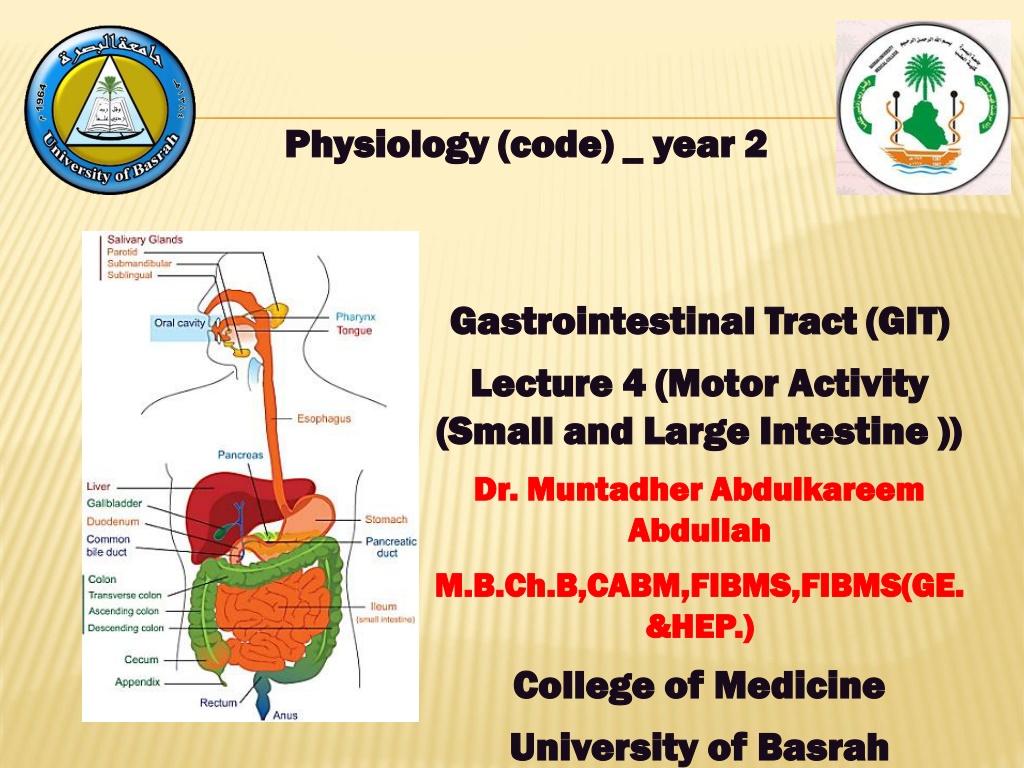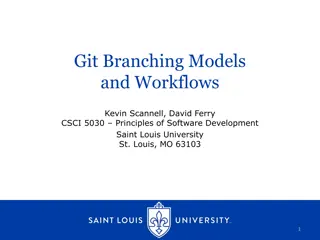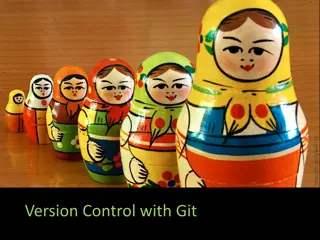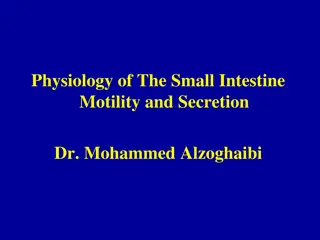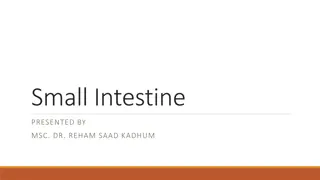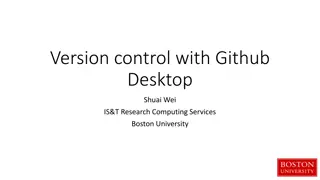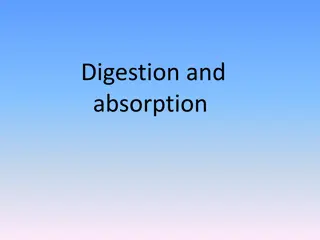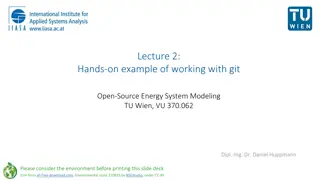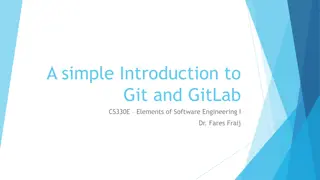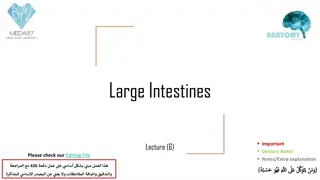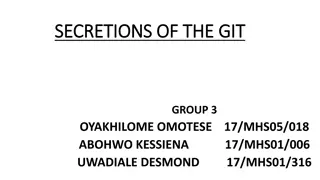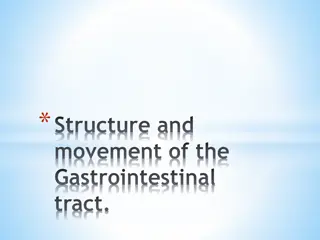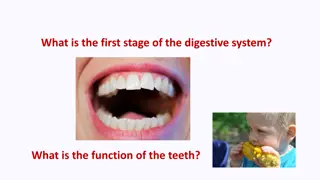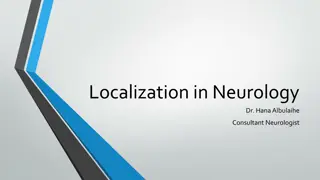Understanding Small Intestine Motor Functions and Control in GIT Physiology
The lecture discusses the motor functions of the small intestine, including segmentation and peristaltic contractions. It covers factors affecting intestinal peristalsis and the role of gastro-enteric reflex. The small intestine's structure, functions in digestion and absorption, and common disorders are also explored.
Download Presentation

Please find below an Image/Link to download the presentation.
The content on the website is provided AS IS for your information and personal use only. It may not be sold, licensed, or shared on other websites without obtaining consent from the author. Download presentation by click this link. If you encounter any issues during the download, it is possible that the publisher has removed the file from their server.
E N D
Presentation Transcript
Physiology ( Physiology (code) _ code) _ year year 2 2 Gastrointestinal Tract (GIT) Gastrointestinal Tract (GIT) Lecture Lecture 4 4 (Motor Activity (Motor Activity (Small and Large Intestine )) (Small and Large Intestine )) Dr. Muntadher Abdulkareem Dr. Muntadher Abdulkareem Abdullah Abdullah M.B.Ch.B,CABM,FIBMS,FIBMS(GE. M.B.Ch.B,CABM,FIBMS,FIBMS(GE. &HEP.) &HEP.) College of Medicine College of Medicine University of University of Basrah Basrah
Objectives: 1.Describe the motor functions of the small intestine and the control of that functions and discuss the functional disorders. 2.Describe the motor functions of large intestine and the control of the functions and discuss the motor functional disorders. University of Basrah-College of Medicine-Physiology Department 1
Small Intestine The major site of digestion and absorption of carbohydrates, proteins and fats in the GIT. The small intestine is approximately 5m long and has three parts: the duodenum, the jejunum and the ileum. It is large surface area is created by numerous folds of the intestinal mucosa, by densely packed villi, which line the entire mucosal surface, and by microvilli, which protrude from the surface of the intestinal cells and give the intestinal mucosa it is characteristics brush border appearance. University of Basrah-College of Medicine-Physiology Department 2
Movements of the small intestine: Segmentation (mixing):It is the most common type of intestinal contraction., about 2cm. of the intestinal wall contracts, forcing the chyme back toward the stomach and toward the colon. Segmentation contraction occur throughout the digestive period and they occur more frequent in the duodenum than the ileum. Peristaltic contraction: contraction of a small section of proximal muscle if followed immediately by relaxation of the muscle just distal to it, resulting wavelike motion moves food along the GIT in a proximal to distal direction. Peristaltic activity of the small intestine is greatly increased after meal. This is caused partly by 1-the entry of the chyme into the duodenum and partly by 2-the gastroentric reflex that is initiated by distension of the stomach and conducted through the enteric nervous system from the stomach down along the wall of the small intestine. University of Basrah-College of Medicine-Physiology Department 3
University of Basrah-College of Medicine-Physiology Department 4
Factors affecting intestinal peristalsis: 1.Food in the stomach gastro-enteric reflex increase peristalsis of small intestine (to make more place for the chyme coming from stomach), also called gastro-ilial reflex because this reflex is not only associated with increased intestinal peristalsis but also leads to opening of ilio-caecal valve. 2.Over distention of S.I causing more peristalsis. 3.Irritation of mucosa of S.I: The peristalsis will much more increase than normal this irritation could be due to bacteria, virus, toxins, chemical substances and even food itself . The increased peristalsis is mediated by myenteric nerve plexus. This irritation is called enteritis usually associated with diarrhea. University of Basrah-College of Medicine-Physiology Department 5
4. intestinal obstruction: Mechanical obstruction which may be inside the lumen (foreign body) or may be outside like (tumor) increase peristalsis in the area behind the obstruction (to overcome the obstruction) fatigue of smooth muscle in this area. The chyme from stomach will be accumulate behind the obstruction abdominal distention, colicky abdominal pain, and constipation. If the obstruction is near the stomach vomiting. Treatment is by surgical removal of the obstruction. Untreated death (due to death of the intestine septicemia and due to disturbance in acid base balance because of vomiting). University of Basrah-College of Medicine-Physiology Department 6
Sympathetic reflexes initiated by irritation: 1.Abdomino-intestinal reflex due to irritation of abdominal muscle that will inhibit intestinal peristalsis. 2.Peritoneo-intestinal reflex due to irritation of the peritoneum 3.Intestino-intestinal reflex due to irritation of any part of S.I will inhibit peristalsis. 4.Reno-intestinal reflex due to irritation of kidney. 5.Vesico-intestinal reflex due to irritation of bladder. 6.Utero-intestinal reflex due to irritation of uterus. These irritations and these reflexes are occurs after lapratomy the peristalsis is greatly inhibited (patient after such operation should not have any food by mouth). University of Basrah-College of Medicine-Physiology Department 7
Large intestine The large intestine starts with caecum then ascending colon, transverse colon, descending colon, sigmoid colon, rectum, and anus . University of Basrah-College of Medicine-Physiology Department 8
The main function of colon (large intestine) is 1-absorption of water and Na+from feces (stool) 2-It promotes the excretion of fecal material remaining in the colon. The motor function of large intestine: 1. Mixing movement (haustration): The combined contractions of the circular and longitudinal smooth muscle cause the portion of large intestine to bulge outward into a baglike sacs called haustration, therefore, the fecal material in the large intestine is squeezed, moving back and forth along the colon. University of Basrah-College of Medicine-Physiology Department 9
2. Peristalsis: It is the progressive contractile wave preceded by a wave of relaxation to push the stool very slowly along the colon. 3. Mass movements: It is a modified type of peristalsis from transverse colon to the sigmoid, cause evacuation of stool to the outside. It occurs about 2-3 times/day University of Basrah-College of Medicine-Physiology Department 10
Defecation: The getting rid of fecal materials outside the GIT. Between the sigmoid and the rectum there is a sphincter called sigmoido-rectal sphincter which is closed always at normal conditions and when there is no defecation so the rectum is empty. There is internal anal sphincter (smooth muscle) and external anal sphincter(skeletal muscle). The internal anal sphincter supplied by ANS (autonomic nervous system) while the external anal sphincter is supplied by pudendal nerve. University of Basrah-College of Medicine-Physiology Department 11
Defecation is a reflex started by a nervous reflex then continues voluntarily, when there is accumulation of fecal materials more than capacity of sigmoid colon some of this will pass to the rectum so this will stimulate the mechanoreceptors 2 reflexes: 1. Intrinsic defecation reflex mediated by enteric nervous system. 2. Extrinsic defecation reflex mediated by parasympathetic nervous system. These reflexes lead to increase in rectal peristalsis and relaxation of the internal anal sphincter . University of Basrah-College of Medicine-Physiology Department 12
. When the pressure inside the rectum reach to 60 mmHg the reflex of defecation started impulses will go from rectum to higher center in brain (at the same time of occurrence of the last 2 reflexes) central inhibitory impulses will inhibit the pudendal nerve (relaxation of external anal sphincter) Bacterial action in the especially colon bacilli, are present in the proximal half of colon(absorbing colon). The substances formed as a result of bacterial activity are vitaminB12, vitamin K, thiamin, riboflavin and various gases that contribute to flatus in the colon especially carbon dioxide, hydrogen gas, N2and methan. The colonic gas produced chiefly through the breakdown of undigested nutrients that reach the colon. colon: Numerous bacteria University of Basrah-College of Medicine-Physiology Department 13
Recap: Small Intestine the major site of digestion and absorption of carbohydrates, proteins and fats in the GIT. The small intestine is approximately 5m long and has three parts: the duodenum, the jejunum and the ileum. The movements of the small intestine: Segmentation (mixing) and Peristaltic contraction. The large intestine starts with caecum then ascending colon, transverse colon, descending colon, sigmoid colon, rectum, and anus. Mixing movement (haustration): The combined contractions of the circular and longitudinal smooth muscle cause the portion of large intestine to bulge outward into a baglike sacs called haustration, Peristalsis the progressive contractile wave preceded by a wave of relaxation to push the stool very slowly along the colon and mass movements (defecation) which is a modified type of peristalsis from transverse colon to the sigmoid, cause evacuation of stool to the outside. It occurs about 2-3 times/day. University of Basrah-College of Medicine-Physiology Department 14
Questions: Explain the following: 1. Intrinsic & extrinsic defecation reflex. 2. Patient after lapratomy should not have any food by mouth. University of Basrah-College of Medicine-Physiology Department 15
